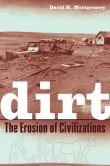In 2011 more than half of the terrestrial world’s carbon uptake was in the southern hemisphere – which is unexpected because most of the planet’s land surface is in the northern hemisphere – and 60% of this was in Australia.
That is, after a procession of unusually rainy years, and catastrophic flooding, the vegetation burst forth and the normally empty arid center of Australia bloomed. Vegetation cover expanded by 6%.
Human activity now puts 10 billion tonnes of carbon into the atmosphere annually, and vegetation in 2011 mopped up 4.1 billion tonnes of that, mostly in Australia.
There remains a great deal of uncertainty about the carbon cycle and how the soils and the trees manage the extra carbon. Nobody knows what will happen to this extra carbon now in the hot dry landscapes of Australia: will it be tucked away in the soil? Will it be returned to the atmosphere by subsequent bushfires?
As scientists are fond of saying, more research is necessary.
How Nature Affects the Carbon Cycle


No comments:
Post a Comment